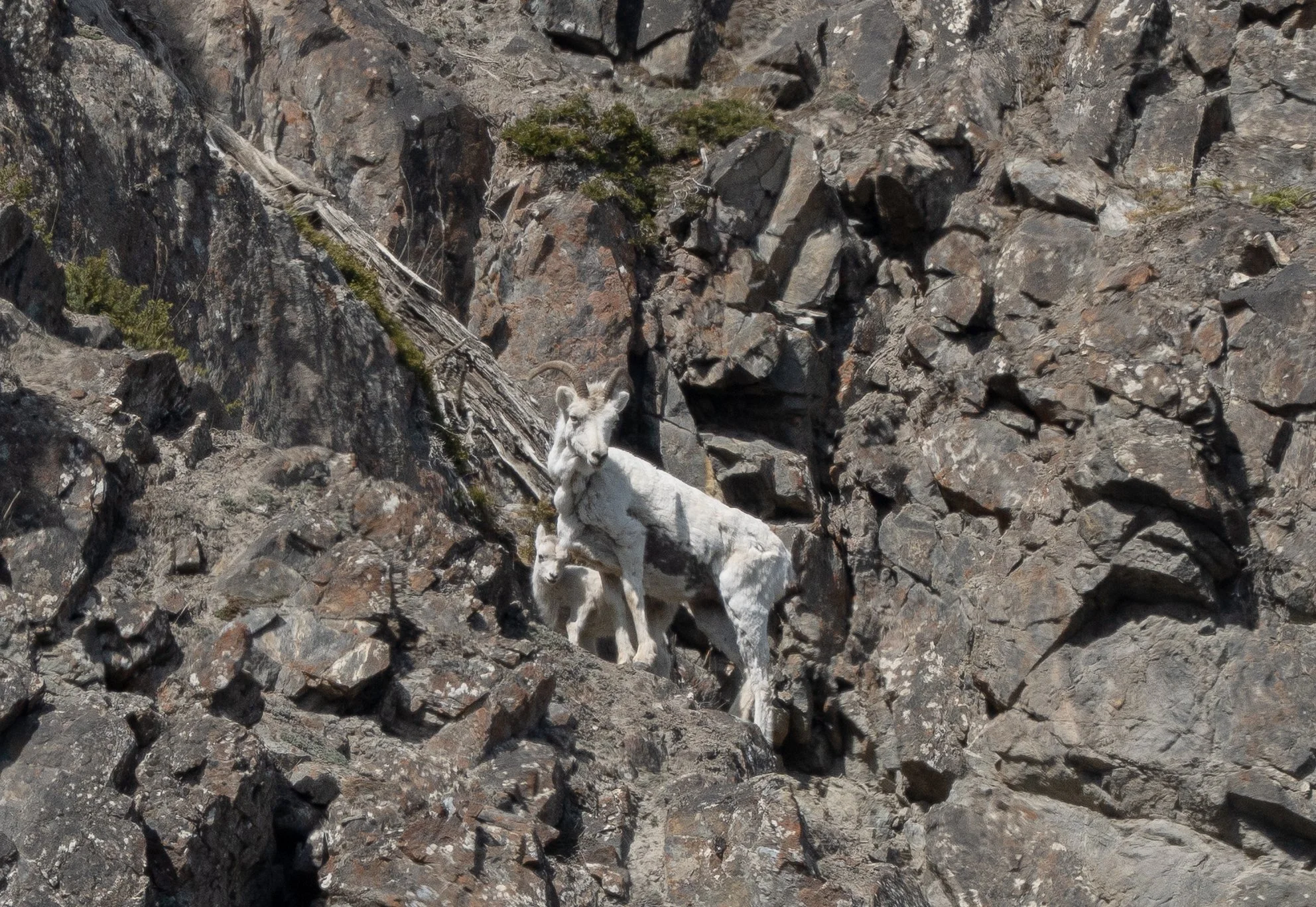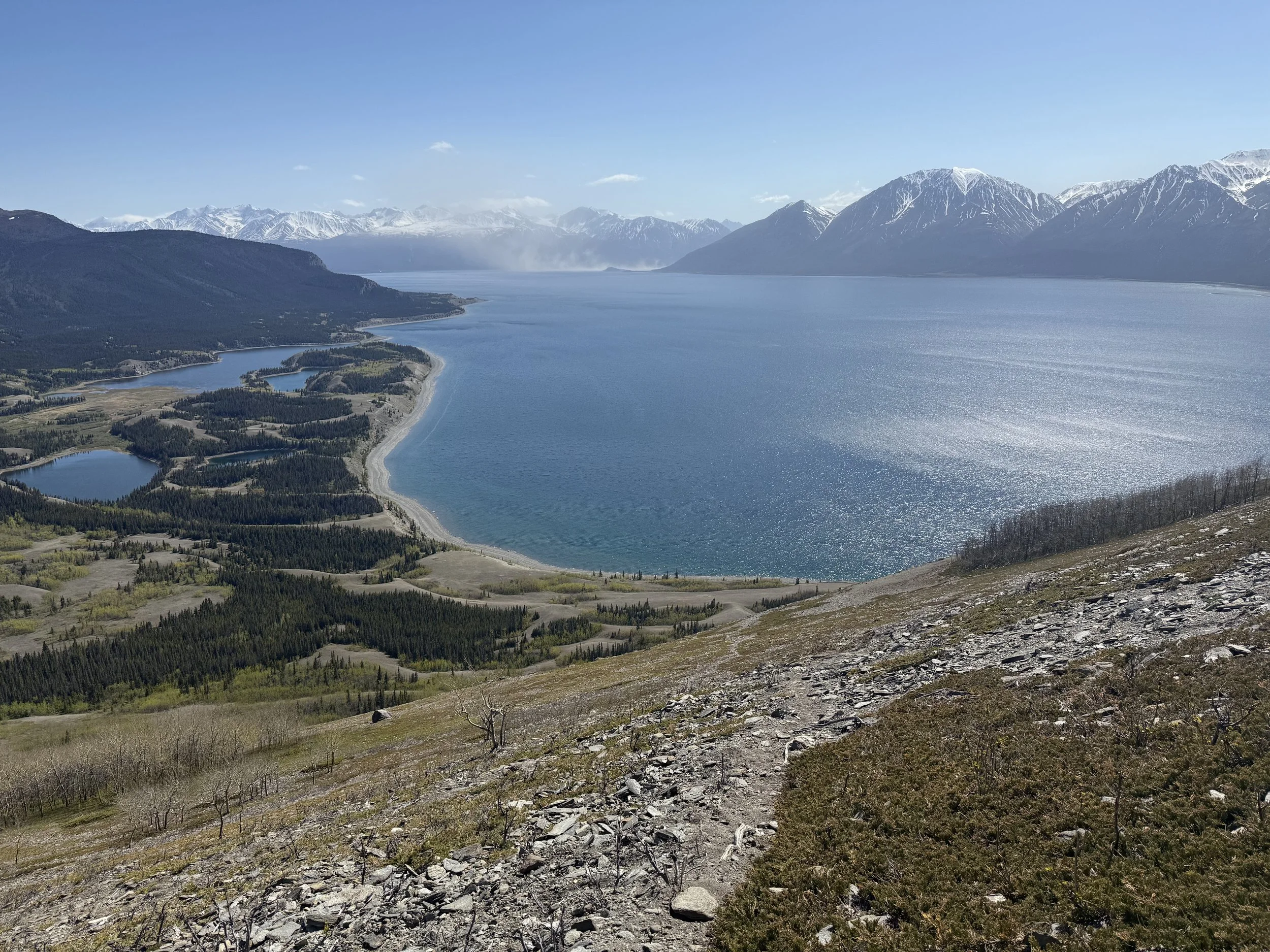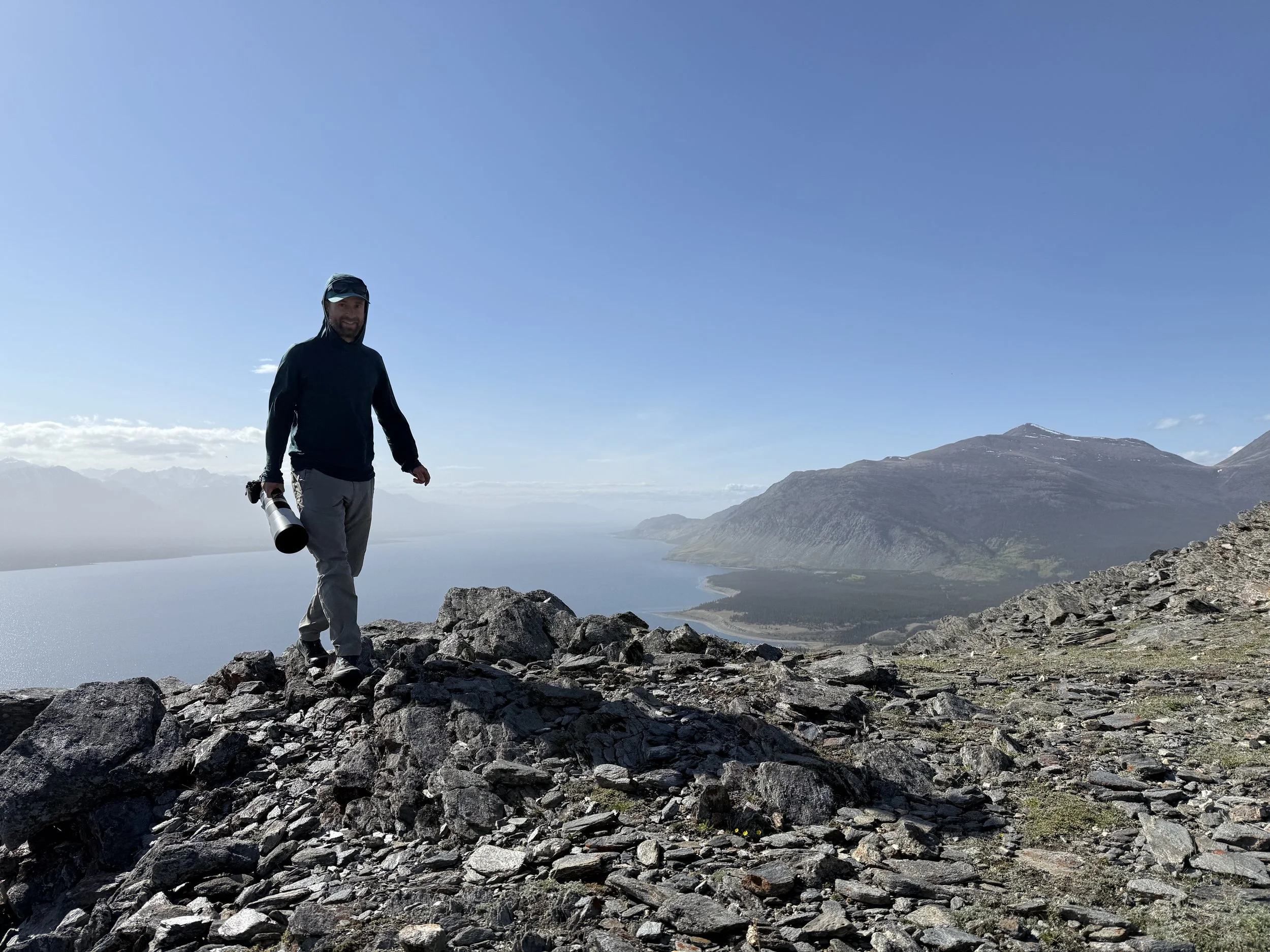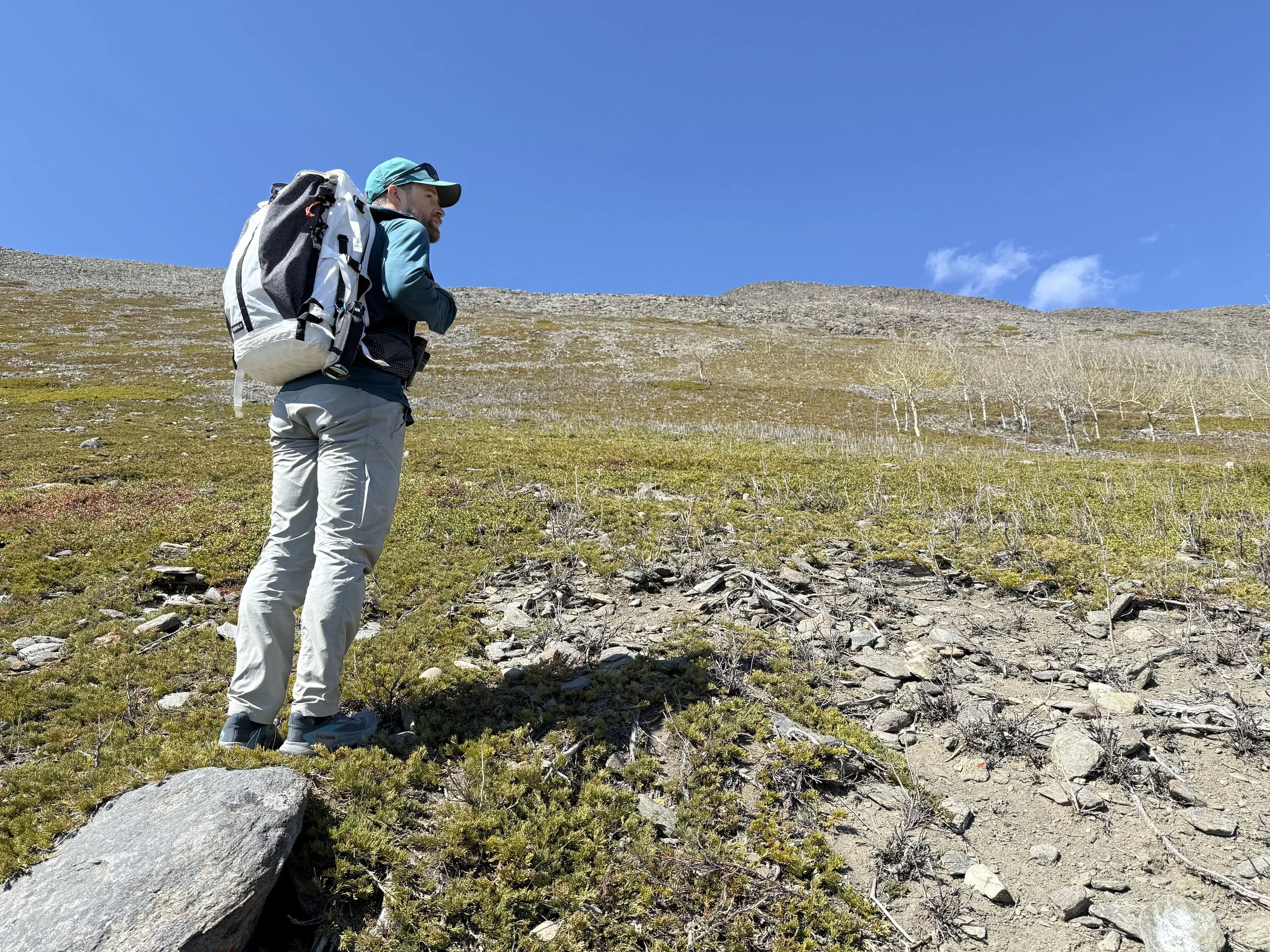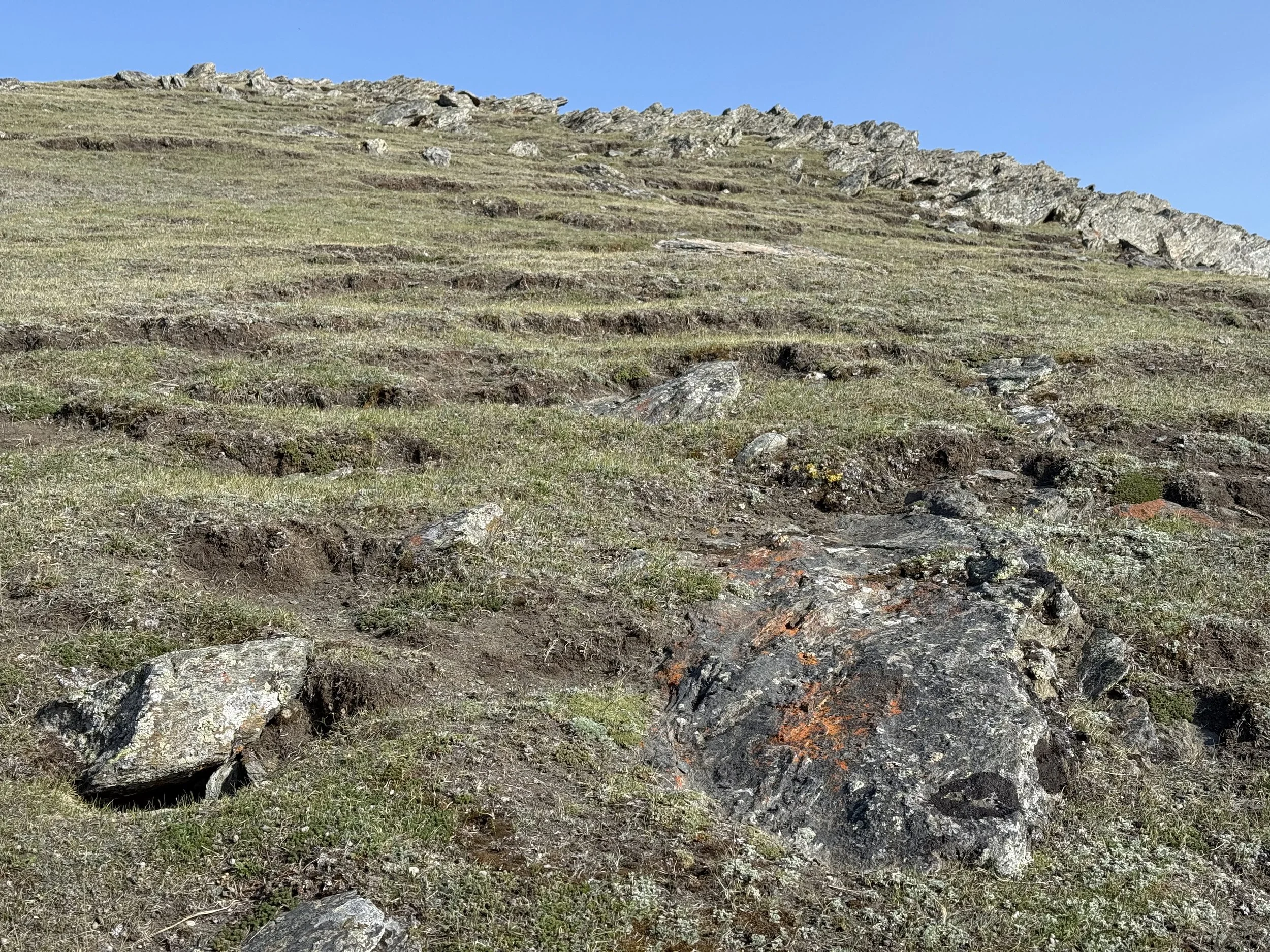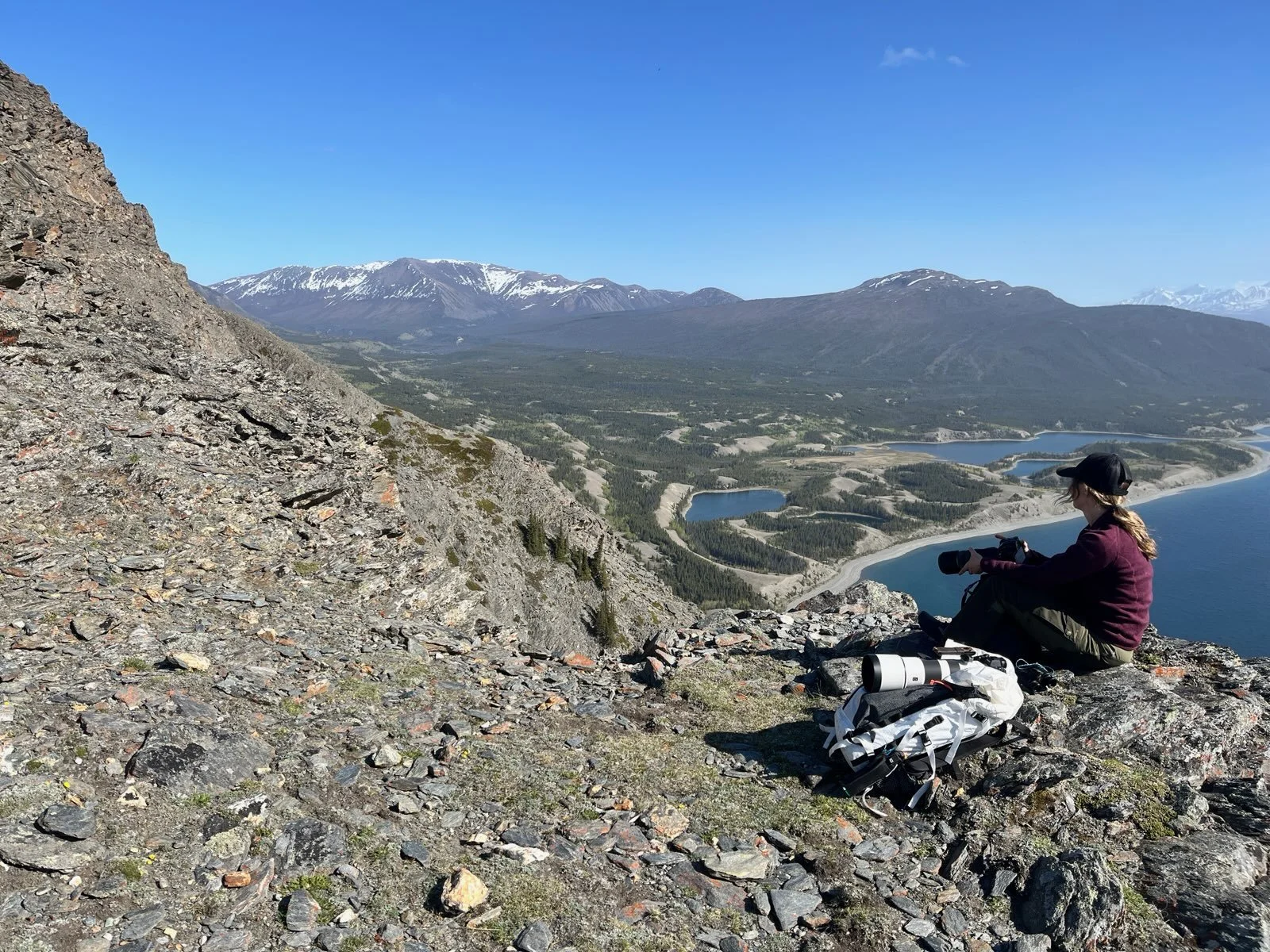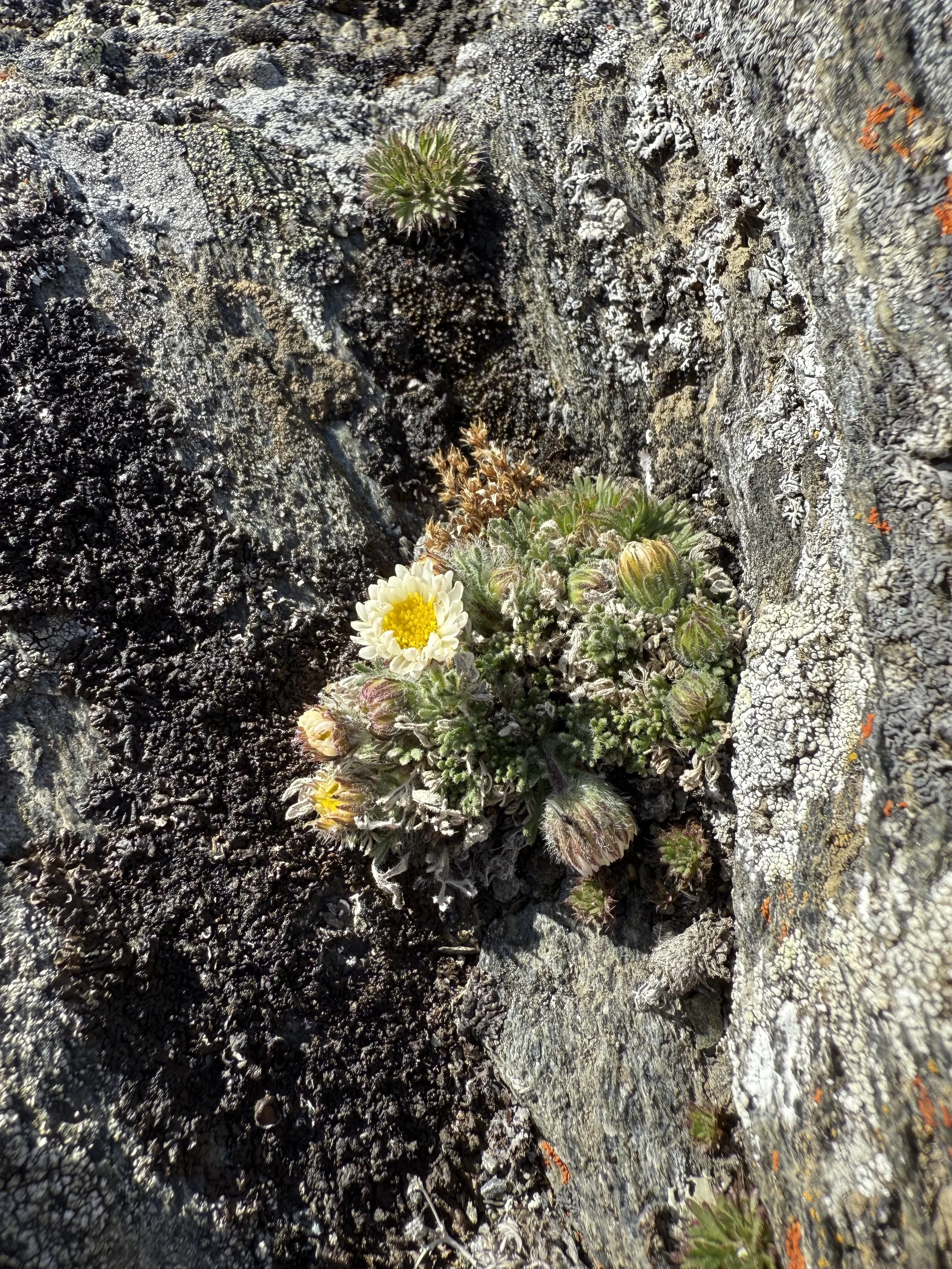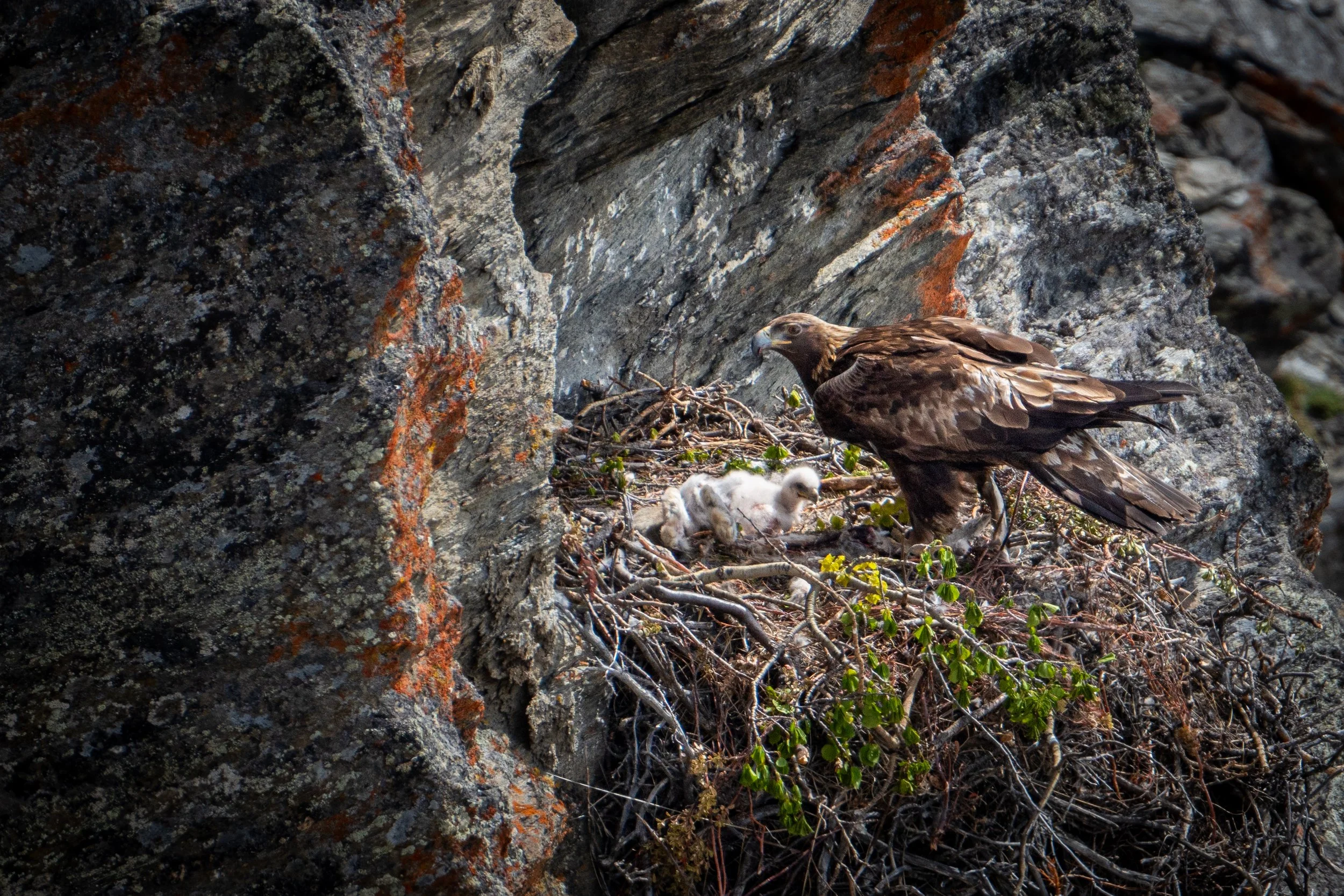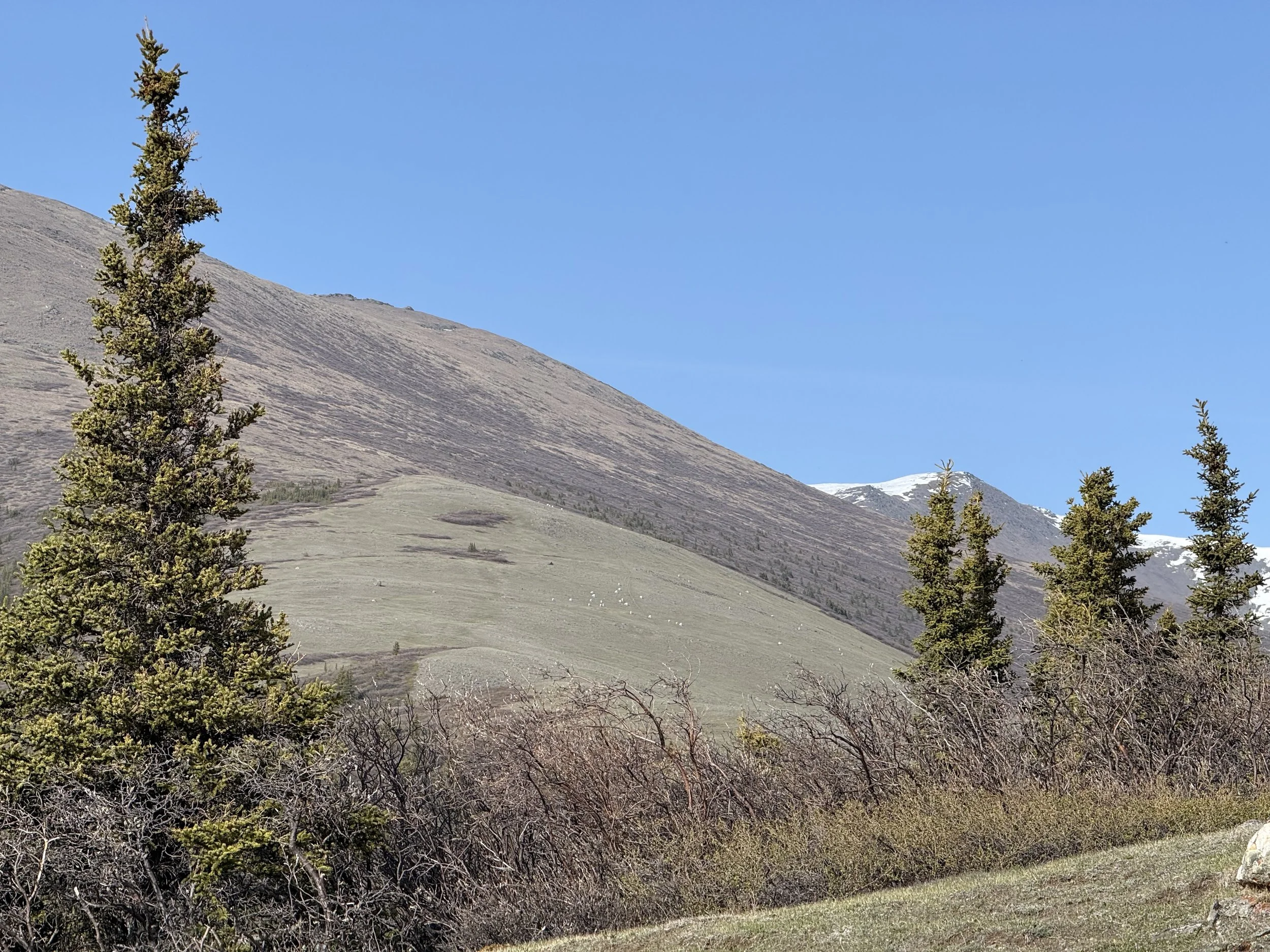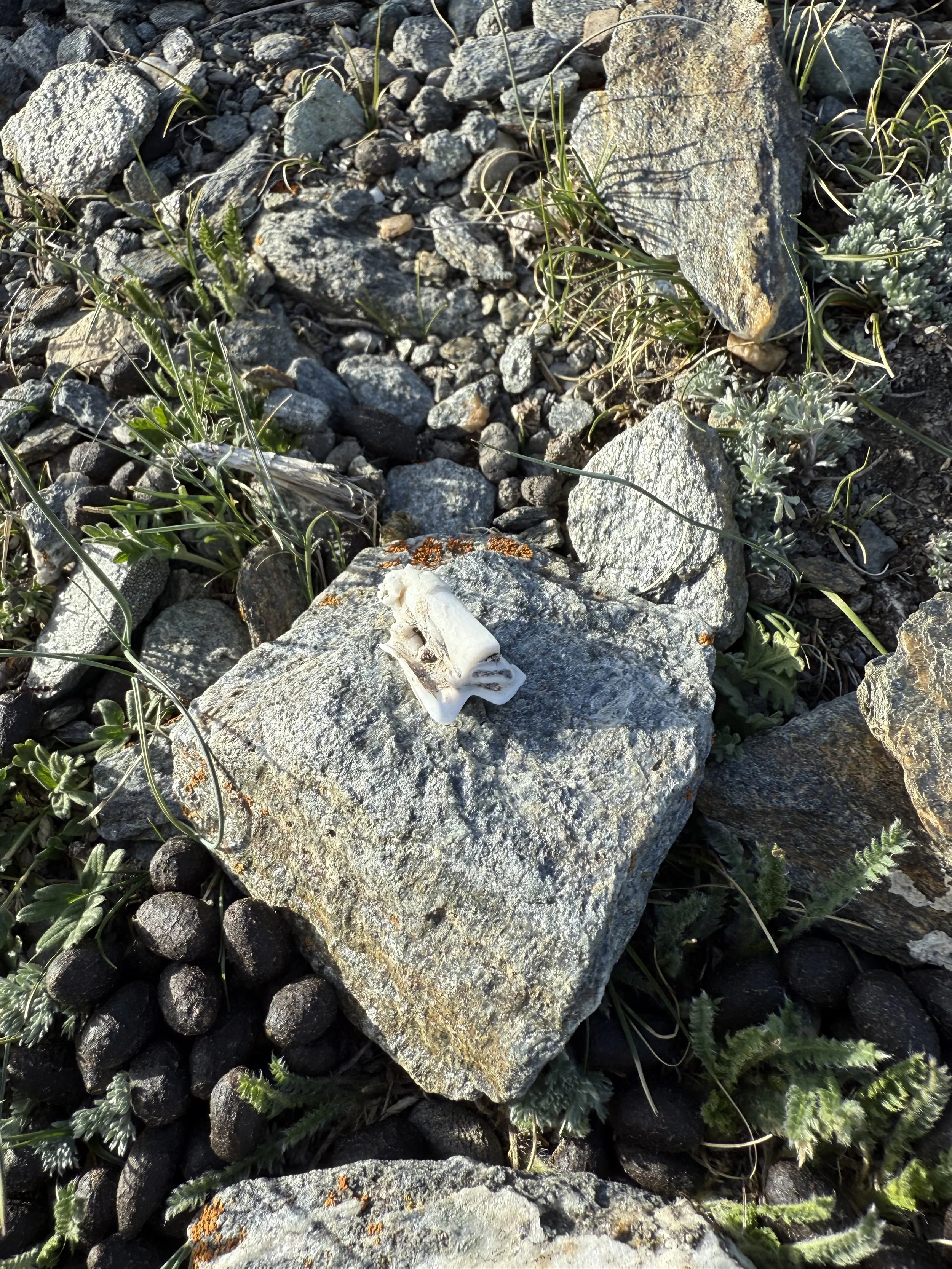Following the Trails of the Disappearing Dall Sheep
ON ASSIGNMENT FOR CANADIAN GEOGRAPHIC IN KLUANE NATIONAL PARK
Sonny parks his truck along the eastern shore of Łù’àn Män, or Kluane Lake—the largest lake in the Yukon. The lake that feels like an ocean churns with whitecaps. The expression of an Elder from Kluane First Nation echoes in my ears: down on the blue rollers.
Earlier that morning, she told us stories about how her community used to set nets on the lake for trout, grayling, and whitefish, but they can’t do that anymore—the lake has dropped by three metres. In May 2016, after an extreme warming period, glacial meltwater from the Kaskawulsh Glacier diverted from the Ä'äy Chù River (Slims River), which had formerly poured into Kluane Lake, to a river that flows into the Gulf of Alaska. Scientists calls it “river piracy”.
Łù’àn Män, or Kluane Lake is drying up.
The wind whips a massive column of dust across the lake. Glacial dust from the dry, exposed riverbed will rise and settle on the sage and lichen and plant covered mountain slopes and grind down the molars of the sheep who feed on them. Is the dust affecting the plants, or the sheep, or both? Scientists are trying to find out.
It’s all connected, I’m learning, the melting glacier, the stolen river, the receding lake, the dust, the sheep, and the people who depend on it all.
I’ve come to the Kluane region to join Yukoner, Sonny Parker, an award-winning wildlife photographer, to tell a story about the startling disappearance of Dall sheep (40 to 60 percent declines in some herds) for Canadian Geographic, but after speaking with Elders and scientists, I realize that I can’t write about sheep without writing about the geopolitical and ecological complexity of this landscape.
“I have no idea how you’re going to weave those interviews together,” Sonny says.
I nod and feel a bit overwhelmed with the ideas and stories that have been so generously shared with me churning in my mind like the waters of Łù’àn Män. There is an enormous responsibility—to people, wildlife, and land—in telling stories. There is the fear of who am I to write this story. But I remind myself that I feel this way every time I sit down to write.
This isn’t about imposter-syndrome. It’s a constant reminder that stories are sacred matter and I am just a visitor. I have to take great care in how I weave together words that don’t belong to me.
But for now, I can set aside the words and stories and take a breath. Sonny points to a steep, rocky cliff—near vertical—that looms above us, forming a natural lookout. That’s where we’re headed. We’ve spoken with the ‘sheep people’ and now we are in search of the sheep, themselves.
I follow Sonny along a trail in the valley that’s familiar to sheep, bison, and bears, and Sonny himself. He’s spent hours, days, weeks along these mountainsides, observing and documenting what he sees. You can feel it when you look at his images of Dall sheep, that remarkable intimacy that’s granted when wild animals allow you into their domain. You often can’t get close to an animal without understanding something vital about how they behave and interpret the world around them.
As we trek up the mountainside, my heart is already working overtime. There’s no sure footing here, it’s all loose soil and shale rock and sheep scat, pellets hardly bigger than black beans. The trail, I realize, is a sheep’s trail carved into the slope. It doesn’t lead straight up, but rather, zigs and zags. I’m grateful that the sheep, perhaps, are not unlike us: they want to conserve energy, too. Their hard-rimmed evolved hooves act like climbing shoes. They were built for this terrain—the gnarlier the better for escaping and out-navigating less sure-footed predators.
“Any tips for approaching sheep?” I ask Sonny, my lungs already heaving from the climb.
“I try not to look like a predator, or like I’m sneaking up on them,” he says. “I stay in the open and give them time to see me approaching. Then they can decide if they want to move off, or if they’re okay with me,” he tells me.
There are many predator species that stalk and hunt Dall sheep: grizzly bears, black bears, lynx, coyotes, and—yes—people, too. (A Dall sheep trophy hunt in the Yukon can cost between $50,000 to $70,000. A lottery hunt in the Kluane region once sold to an American for over $300,000 dollars).
But me—a predator? No issue there, I think. The mountainside has turned me into the clumsiest, weakest version of myself. I make the mistake of glancing down and experience a wash of vertigo rise up from my gut to my skull. I curse myself for not bringing hiking poles. In one steep section, I bend forward and use my hands, awkwardly walking on all fours, to steady myself.
“Don’t tell anyone I’m actually afraid of heights,” I mutter to Sonny who, himself, must be half-man-half-sheep because he seems so naturally at ease on the slope.
After thirty-minutes of our uphill ascent, the mountain mercifully levels out and I follow Sonny along the grassy ridge that leads to the rocky lookout. Tiny sage and lichen cover the thin soil. Out of the mad winds, everything goes quiet and I can finally appreciate where I am.
The air is perfumed with something sweet: sage, scat and the sheep, themselves. While there’s no herd physically in sight, I can sense they were here, maybe only hours earlier. It’s a feeling that humbles, as though being alone in someone else’s home: you tread carefully.
I marvel at the ways sheep have engineered the landscape. They paw with their hooves as they graze, which appear to have formed something like linear terraces along the slope.
Sonny leads me up over a final pass and down to the rocky cliff that dangerously drops off below. The shimmering blue waters of Łù’àn Män, or Kluane Lake magnetically draws the gaze. It’s difficult to comprehend that this colossal body of water is receding before our eyes. Sonny points down to what used to be known as Cultus Bay—a former bay connected by a narrow channel of water—but is actually now a lake. Cultus Lake sits at least a metre higher than Kluane Lake.
We rest on the sun-warmed rocks covered with lichens with mouthwatering names like “sunburst” and “black rock licorice”. Tiny alpine flowers sprout from crevices.
“How close have you been to the herds when you photograph them?” I ask and Sonny tells me that while every encounter is different, there’s been times when sheep have approached him, drawing so close he could reach out and stroke their lush white fur.
“Sometimes I talk to them,” he says. “The best encounters are when they’re relaxed and just being sheep and it’s like I’m not even there.”
He points out a cave-like opening in the rocks less than a few metres away.
“I crawled in there once and found sheep scat,” he tell me. “Maybe it was a lamb hiding? I’m not sure, but it seemed too small for an adult [sheep].”
In the first month after they’re born, Dall sheep lambs face a 50 percent chance of mortality. It doesn’t take long for lambs to grow into those sturdy mountain legs—maybe a week, no more—but in those first days they’re particularly vulnerable. And their predators know this.
This is the place where Sonny somewhat incredulously observed a black bear stalk along a steep ridge to nab a newborn lamb—the umbilical cord was still dangling. He felt a mix of emotions, photographing the encounter, as the lamb’s mother stood helplessly nearby.
“It’s tough to see, but I always try to flip it. The bear is taking a big risk going up to this precarious cliff,” he says. “It’s just kind of the way nature goes.”
And there’s another predator that lives near this very spot. Sonny glasses the vertical face of the mountain below with his binoculars, hoping to catch a glimpse of one.
Suddenly, a large brown bird with a wingspan of two metres swoops out from a small ledge and circles higher into the sky. A golden eagle, the largest bird of prey in North America, soars over the mountains beyond, no doubt, looking for a meal of a newborn lamb.
“There’s the nest,” says Sonny, passing me the binoculars.
After several minutes of scouring the rock, I finally see what took Sonny only seconds, a grey tangle of sticks balancing atop the ledge, barely discernible against the rock face. A small fuzzy white head is visible from the nest: the eagle chick.
In the Yukon, golden eagle chicks hatch in the first week of June—perfectly timed with Dall sheep lambs. Golden eagles are one of the fiercest predators of Dall sheep in the Kluane region. Ron Chambers, an Elder from the Champagne-Aishihik First Nation, told me that he’s observed golden eagles swoop at lambs and knock them off the cliffs—then prey on them from below. He spoke of bone caches at the bottom of this particular mountainside. Once, Sonny spotted what looked like a lamb’s foot in a nest.
We sit and wait for the adult to return to the nest. Sonny says they usually depart and return in 30 to 40 minute intervals. Conversation trails off and we sit in meditative silence. A ground squirrel emerges from his den and stands sentinel like a foot soldier. From across the lake, the dust intensifies. No eagle in sight.
“Another ten minutes?” Sonny asks and I nod and we wait and this goes on and on.
Finally, we rise to pack up our belongings, and the golden eagle returns, circling high in the sky above. It seems reluctant to approach the nest, and I wonder if our presence is a deterrent. Time to go.
We return the way we came, following the same sheep trail back down the mountain. Sonny and I spot a large herd of sheep on a distant grassy mountain slope. They are tiny cream-coloured flecks in the distance. Thirty, forty, maybe fifty of them, likely part of the Ruby herd, scattered on the hillside. Sonny isn’t sure if he can see any lambs, but I silently bid them luck.
Halfway down, I find a sheep tooth hidden in the loose shale. It’s bleached white from the sun with dust embedded in the cracks. I hold the tooth in my hand. What happened to the sheep? It’s a question that Indigenous communities and scientists alike are grappling over, and one that Sonny and I will unpack in our upcoming feature for Canadian Geographic.
From across Kluane Lake, dust obscures the sky, opaque as wildfire smoke.
Stay tuned for our feature on the declines of Dall sheep in the Kluane region of southwestern Yukon with Canadian Geographic in the coming months.
Special thanks to Sonny Parker for inviting me to collaborate on this incredibly complex story about climate change, culture, and conservation, and to Parks Canada and individuals from Kluane First Nation, and Champagne-Aishihik First Nation for sharing your stories and perspectives with us.
Shä̀w níthän.
If you enjoyed reading this article, please consider “buying me a coffee” to help support my work as a writer.
